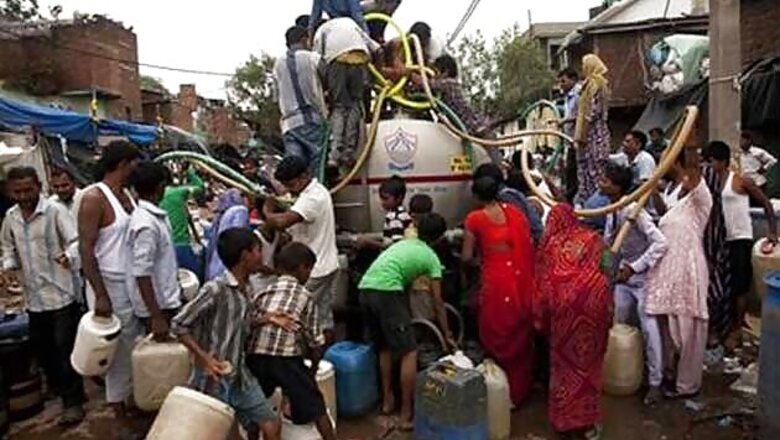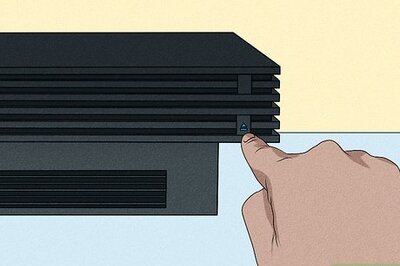
views
New Delhi: Every summer, when Minoo Phakey's water runs out, she does what most people do in her middle-class neighborhood: She calls the mafia.
Within an hour, a man in a tanker arrives, carrying a load of dubious water drawn illegally from the city's groundwater. With India's capital gripped by its annual hot season water shortage, the city's so-called tanker mafia is doing a roaring trade. An estimated 2,000 illegal tankers ply New Delhi's roads every day, lifelines to millions whose taps have run dry, and symptoms of a much bigger problem - the city's desperately dysfunctional water system.
The tankers don't come cheap. But some Delhi-ites have no choice. "You need water, you will pay anything, right?" says Phakey, a marketing executive.
She is hardly alone. In a city known for its vertiginous inequalities, the shortage affects people from both upscale gated communities and dust-blown slums, as every day, the city's supply falls more than 160 million gallons short.
Most residents have piped water for just a couple hours a day, and almost a quarter have none at all. With a leaky water infrastructure long overwhelmed by new arrivals, New Delhi is grappling with a dizzying social and environmental challenge, worsened by chaotic management. For many, it is a distressing reminder of a daily reality that lags behind India's superpower dreams.
While New Delhi has had water troubles for decades, the shortage has become critical in recent years as the city's population has grown with little or no planning, rising from 9 million in 1991 to almost 17 million today.
Even many of the wealthiest neighborhoods get water for just an hour in the morning, with residents rushing to turn on pumps and fill storage tanks when the municipal supply flows.
The most urgent problem, though, is getting water to the sprawling neighborhoods of illegally constructed buildings, home to 40 percent of the city's residents and largely without water lines. The city's water agency, the Delhi Jal Board, sends 900 tankers onto the crowded roads every day. In some neighborhoods, a tanker passes every few minutes, its load sloshing down its sides.
But it's nowhere near enough. Tankers usually stop for just 15 minutes, while dozens of people crowd around waving buckets and plastic tubes. Tempers flare in the fierce heat; fights are frequent. In some areas, people get just 3 liters (quarts).
In a slum in Vasant Kunj, a young woman, Fatima, keeps her entire week's supply in five 50-liter (13-gallon) plastic containers lined up next to her bed. They take up a third of the 3.5-meter (12-foot) metal box where she, her husband and child live.
"Sometimes only one water tanker comes, sometimes they come after a day's gap," says Fatima, who uses only one name. "We are poor people. If we sit and wait like this for a whole day for the water tanker, when will we go out to earn our daily wage?"
New Delhi's water authority downplays the problem. "I wouldn't call it a crisis," says Vijay Kumar, the agency's chief. "If you look at Delhi overall, certain pockets are water-scarce - not all." Those pockets, though, are home to roughly 3.5 million people.
The water board says it doesn't have enough water and largely blames neighboring states, which it says failed to deliver extra water to the city after a 2012 canal renovation. "That is our biggest constraint," says Kumar. "Once we are in position to commission the entire infrastructure, water will be more equitably distributed, more rationally managed. But what is crucial is that we should get more water."
Still, critics say the city - which is close to two major rivers and has a significant water table - shouldn't be running short. In theory, as the World Bank noted, New Delhi should have more water available per capita than Paris.
Instead, they say the water board has squandered its resources.
"Delhi is a very privileged city in terms of water availability. So Delhi seems to be a case of crisis of mismanagement," says Himanshu Thakkar, who runs the New Delhi-based South Asian Network for Dams, Rivers and People, a research and environmentalist organization.
Insiders agree. A 2013 government audit of the water board depicted a system verging on collapse, with projects launched and then halted after years of delays, quality control labs understaffed, and most plants constantly leaking. One plant hadn't been repaired in 57 years.
Management failures mean New Delhi wastes the water it has, distributing it unevenly and, by its own admission, losing 40 percent of its supply a day. Some neighborhoods get more water than they can use while others go dry. Despite repeated audits acknowledging the problems, little has been done to address them.
Often, the board ignores many of the real reasons behind the shortage. For instance, while the board blames leakage for most lost water, experts say more is actually stolen. Sanjay Sharma, a water engineer with the activist group Citizens Front for Water Democracy, says tens of thousands of builders and homeowners have illegally tapped into the city's water mains.
They don't have many other options. With no reliable supply, illegal connections and calls to the water mafia have become routine. Aware they can offer no alternative, authorities largely tolerate it. In any case, the water board only manages to collect water charges on half its authorized connections.
Ramanand Sharma, who runs a small illegal tanker business in southern New Delhi, fills his tankers from illegal wells outside the city, paying off police patrols with $3 bribes. Government tanker drivers also often divert their loads for cash, he says.
"The government water tankers are not under scrutiny," he says. "Everyone knows that they make money, too." Sharma charges 3,000 rupees, or about $50, for a thousand liters, impossibly expensive for most Indians. Other suppliers charge 600 rupees, or around $10, per trip, but that's still beyond most people.
Instead, hundreds of thousands of families dig pumps directly into the increasingly polluted groundwater, paying around 15,000 rupees, or $250, for installation.
That has prompted a precipitous drop in the water table in many areas: In several parts of southern New Delhi, water has been receding by up to 9 feet (2.75 meters) a year, threatening environmental and human disaster.
"There are predictions by the central groundwater authorities that, in decades and not more, some of these areas will be completely devoid of any usable groundwater," says Thakkar, of the New Delhi environmental group.
There are signs of progress. New Delhi's government is completing a massive drainage project, which it says will cut river pollution by almost two-thirds, allowing more water to be pumped from the Yamuna River. A system of underground reservoirs is being constructed to distribute water more equally.
The water board is also experimenting with smaller projects, including pay-per-use water dispensers. Known as "water ATMs," the solar-powered machines offer treated water for a nominal sum in unpiped areas. Five hundred ATMs are to be installed in 10 slums in the next year.
But such projects promise little for the millions in the unauthorized slums where no pipelines are planned. India's new prime minister, Narendra Modi, came to power promising to bring efficiency to the country's chaotic public services, including water. Expectations that the new government would prioritize basic necessities were high.
But three months after his election, his government has yet to set a target date to bring piped water to all New Delhi's citizens. "Just 10 kilometers from his office there is the area that has no piped network. In the capital city of India!" says Sanjay Sharma, the water engineer. "Where is the commitment?"


















Comments
0 comment